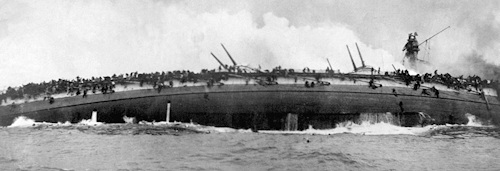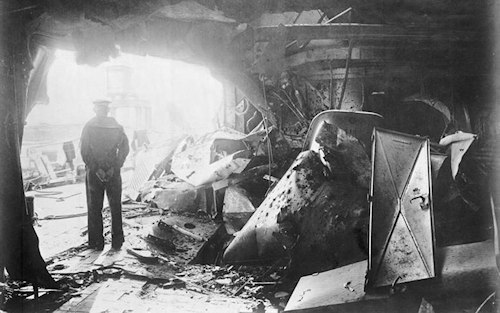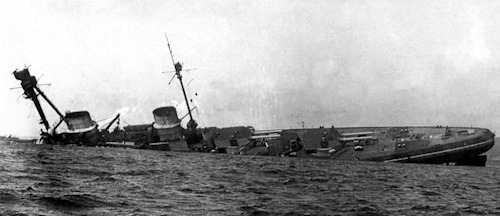At the end of the XNUMXth and the beginning of the XNUMXth century there was a heated naval rearmament race between the German and British Empires (German naval rearmament strongly desired by Kaiser Wilhelm II).
It should be noted that the creation of the first monocaliber main armament battleship, the Dreadnought (commissioned 1906), initially gave the Royal Navy a head start for this type of ship. But this didn't last long... as even the Germans managed, in the following years, to develop new battleships!
From a technical point of view, the new German ships were characterized, in particular, by a slightly smaller main caliber than the British one (280 mm compared to 305; and when the Germans switched to 305, the British were already at 343...) and for much more protection.
To the battlecruisers of the Imperial German Navy From the Tann (launched in 1910), Moltke (launched in 1911), Goeben (launched in 1912) e Seidlitz (launched 1913), all armed with 280mm guns, was followed by the Derfflinger (first equipped with a 305 mm calibre). The cruiser Derfflinger it was designed by Hans Burkner, laid down in the Blohm & Voss shipyard in 1912 and launched in 1913; she entered service in squadron on September 1, 1914.
 WWXNUMX cruiser Derfflinger, as a unit of the 1st Exploration Group commanded by Admiral Franz von Hipper, participated in the operations of 14 December 1914 against the coasts of the United Kingdom, bombarding Scarborough; later took part in the Battle of Dogger Bank in the North Sea on January 24, 1915. From that clash the Imperial German Navy was defeated (among other things, the armored cruiser blucher - photo - was sunk), while for the Royal Navy it was an important tactical success.
WWXNUMX cruiser Derfflinger, as a unit of the 1st Exploration Group commanded by Admiral Franz von Hipper, participated in the operations of 14 December 1914 against the coasts of the United Kingdom, bombarding Scarborough; later took part in the Battle of Dogger Bank in the North Sea on January 24, 1915. From that clash the Imperial German Navy was defeated (among other things, the armored cruiser blucher - photo - was sunk), while for the Royal Navy it was an important tactical success.
However, the key moment for the Derfflinger occurred at the Battle of Jutland (May 31 - June 1, 1916). In fact, the German cruiser in the naval battle, managed to destroy the battle cruiser Queen Mary and took part in the sinking of theInvincible and armored cruiser Defence.
During the battle the Derfflinger, which was commanded by the vessel captain Hartog and had in the lieutenant commander von Hase the fire director, had the arduous task of leading the formation of the battlecruisers of Admiral von Hipper, given that the flagship unit of this last (the Lutzow) was noticeably run down.
 Captain Hartog managed to steer the 1st Exploration Group in what was called “the death ride of the German battlecruisers”1, attacking the Royal Navy's Grand Fleet in order to lessen the heavy pressure on Admiral Reinhard Scheer's High Seas Fleet and, consequently, give the latter the opportunity to free itself from the grip of the British ships.
Captain Hartog managed to steer the 1st Exploration Group in what was called “the death ride of the German battlecruisers”1, attacking the Royal Navy's Grand Fleet in order to lessen the heavy pressure on Admiral Reinhard Scheer's High Seas Fleet and, consequently, give the latter the opportunity to free itself from the grip of the British ships.
In battle the cruiser Derfflinger fired 385 large caliber rounds and was hit by about 17 large and nine medium bullets; moreover, she had six 305 and four 150 guns put completely out of action, and took on 3.400 tons of water.
In fact, the battleship was seriously damaged (so much so that the repair work - photo - lasted until November 1916).
It is good to remember that more than 150 men died in the battle and more than 20 were wounded (it is fair to remember that the Battle of Jutland was a tactical and non-strategic success for the Germans). Later, during the war, the cruiser will continue to participate in various operations in the North Sea.
After the end of the conflict, the Derfflinger reached the bay of Scapa Flow (Scotland) and there (photo) was scuttled (June 21, 1919). Subsequently, the wreck was raised in 1934 to then be permanently scrapped at Rosyth (Scotland).

The German cruiser Derfflinger she had a normal displacement of almost 27.000 tons, while at full load of 31.200 tons. The dimensions of her were 210,4 x 29 x 9,5 m. The engine was composed of two groups of steam turbines on four axes (4 propellers with a diameter of 3,9 m), powered by 14 double coal-fired boilers, plus 4 double oil-fired boilers (this was after 1916). The design power was: 63.000 horsepower, maximum during trials around 76.600, with a speed of almost 26 knots (in shallow waters), effective 27,5. Range was approximately 5.300 miles (at 14 knots).
The ship's armament consisted of: 8 cannons of 305/50, 12 of 150/45, 4 of 88/45; in addition, by 4 500 mm torpedo launchers.
The protection was as follows: 300 mm waterline armour; decks of 80+50; conning tower of 300; 270 artillery towers; casemate of 150; 45 anti-torpedo bulkhead.2
The ship could count on a crew (including officers) of about 1114 men.
1 See A. Fraccaroli, The battle cruiser Derfflinger, in Storia Illustrata, n°145, 1969, p.125
2 See ibid
Photo: web












